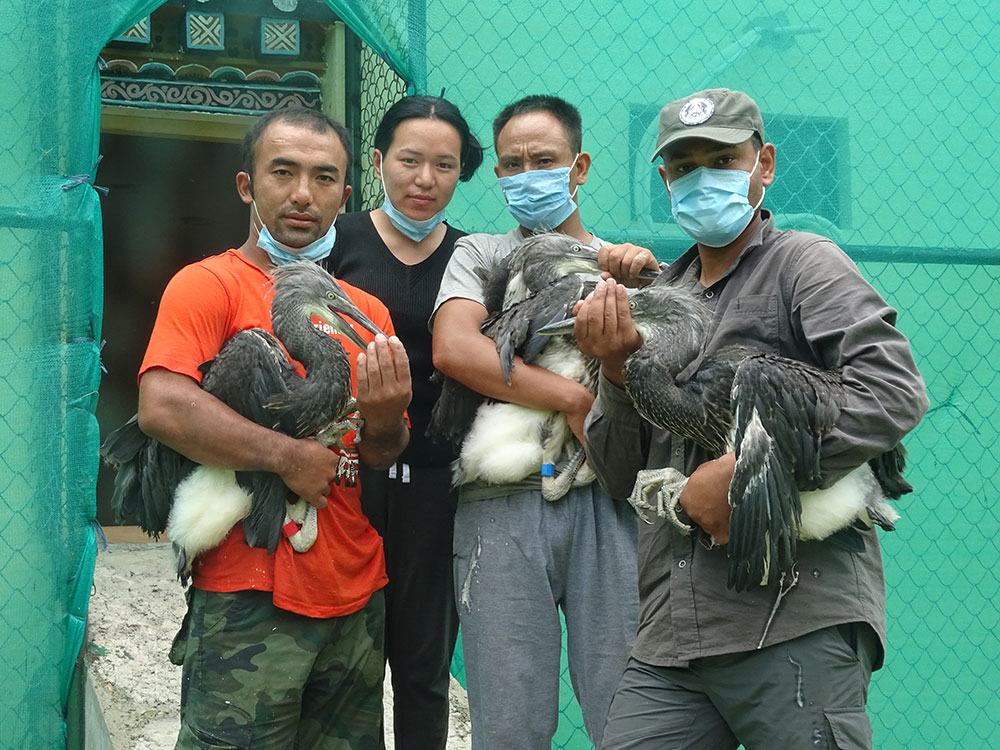Yangyel Lhaden
CHACHEY DOVAN, TSIRANG – In June, I embarked on a memorable expedition to the White-Bellied Heron (WBH) Conservation Centre, nestled amidst the picturesque landscapes of Chachey Dovan, Tsirang.
Accompanied by the Royal Society for Protection of Nature (RSPN) team, I was granted access to the heart of a vital mission—the preservation of the majestic WBH.
I was excited and prepared to encounter the enigmatic WBH. I had previously delved into the world of this remarkable bird during my college assignments, but this encounter would bridge the gap between theory and reality.
Traversing a winding road leading to the conservation centre, the journey to the sanctuary was adorned with abundant lush greenery, harmonious sounds of insects and birds, and a refreshing cool breeze.
Although Chachey is known for its scorching heat, the recent rain blessed us with remarkably pleasant weather during our visit.
Within the sanctuary’s two aviaries, we were greeted by three of the 27 WBHs recorded this year. It is noteworthy that Bhutan is home to more than half of the global population of these captivating birds.
While the RSPN team conducted their important meetings during the day, I spent hours captivated by the mesmerising presence of the WBH. Through a small mesh opening, I had the privilege of observing them up close. The sight of these majestic and tall creatures far exceeded any expectations set by mere pictures.
The male heron, rescued from Phibsoo Wildlife Sanctuary, preferred a secluded spot behind a bush near a tree within the aviary. The female heron, on the other hand, maintained her distance, reflecting the well-known solitary behavior characteristic of the WBH.
An enthralling moment unfolded when I witnessed a female heron slowly approaching the male heron. As she drew nearer, the male heron assumed an alert position, intriguing me with the potential of a heron confrontation. Yet, to my surprise, they passed each other without incident, leaving me in awe of their intriguing interactions.
A truly astonishing event awaited me the following morning as I joined the staff in feeding the herons. Expecting to witness the retrieval of frozen fish, I was amazed when the staff began fishing directly from a nearby pond, offering freshly caught fish to the herons in a bowl filled with water and fish. Their agile movements as they swiftly devoured each fish left me deeply impressed.
The staff’s commitment to nurturing these herons to ensure their survival in the wild was evident in every aspect of their care routine.
Sonam Tshering, a senior research assistant, said that they replicate the herons’ natural feeding time of 6am by providing them with fish equivalent to 10 to 20 percent of their body weight.
The veterinary officer, Samten Leki, diligently conducts regular examinations on the herons to monitor their health and ensure their well-being. The absence of diseases and parasites in their recent test results reflects the centre’s effective care practices.
In one of the evenings, after the day’s meetings, the RSPN staff took me to witness the WBH in its natural habitat at Rilangthang. Positioned by a cliff’s edge overlooking a river, we observed an active WBH nest on the opposite bank.
Under the guidance of an RSPN staff member, I peered through binoculars, determined to spot the WBH in its wilderness. My perseverance was rewarded when I finally glimpsed a female WBH diligently incubating her eggs.
Unfortunately, the staff informed me that the eggs would not hatch, as they had already exceeded their incubation period.
This poignant moment underscored the significance of the RSPN conservation centre in safeguarding the WBH’s ex-situ breeding gene pool. By breeding these magnificent birds outside their natural habitat with the aim to reintroduce them to the wild, the centre plays a vital role in boosting their population, particularly when wild breeding becomes challenging due to limited numbers and threats from predators.
Indeed, the centre serves as an instrumental guardian of these endangered species, preserving their existence, and contributing to the biodiversity of the ecosystem.
As I concluded my journey, I was deeply moved by the tales of WBH survey efforts in the wild and the unwavering dedication of the RSPN team to caring for these magnificent creatures at the center.
This experience has instilled in me a profound understanding of the immense efforts required to safeguard and cherish these critically endangered species. The majestic beauty of the white-bellied heron will forever resonate within my heart, a testament to the tireless work of those committed to its conservation.


